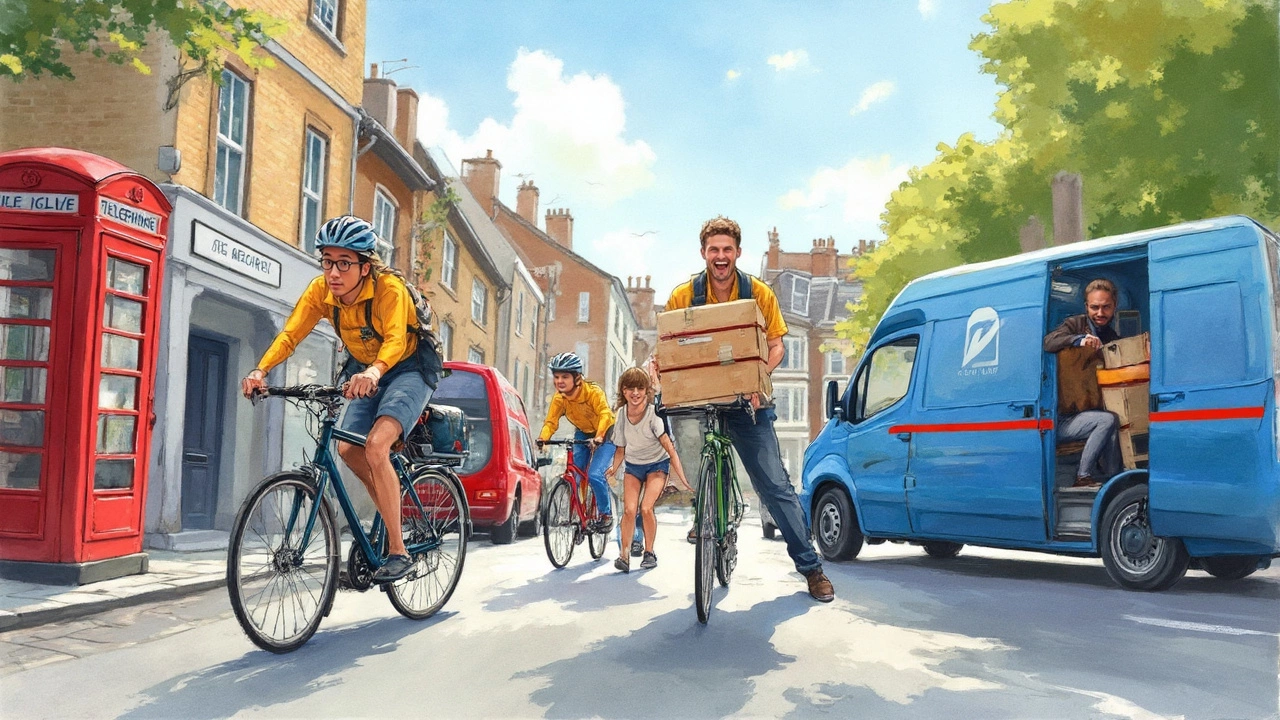Sending stuff by courier isn't rocket science, but there are a few things you need to get right to ensure your parcel arrives safely. First, consider the courier service you're going to use. There are tons out there, from small local couriers to big global players like DHL or FedEx. Picking the right one can depend on factors like delivery speed, cost, and reliability.
Next, think about how you pack your item. A lot of folks underestimate this, but packaging can make or break your courier experience. Use sturdy materials and plenty of padding to protect what's inside – especially if it's fragile. And, of course, make sure you seal it up tight!
Don't forget the documentation. This can involve anything from a simple shipping label to detailed customs forms if you're sending internationally. Knowing the paperwork you need can save you a lot of headache down the line.
- Choosing the Right Courier
- Packing Your Item Securely
- Understanding Documentation
- Tracking Your Parcel
- Insurance and Liability
Choosing the Right Courier
Picking the right courier can feel a bit overwhelming with so many options out there. But don't worry, we've got you covered. The first thing you want to think about is what’s most important to you: speed, cost, or reliability? Each courier service has its strengths. For instance, if speed is your main concern, go for express services offered by companies like DHL, UPS, or FedEx.
If you're looking to save money, check out local or regional couriers. They often provide cheaper rates for package delivery, especially if you aren’t in a rush. Some companies also offer discounts for bulk shipping, so if you send packages frequently, it's worth looking into.
Reliability is key if you're sending something valuable or time-sensitive. Reading reviews can be a lifesaver here. Websites like Trustpilot offer customer reviews for various courier services, giving you a better idea of who you can trust. Word of mouth is also powerful; ask around if any of your mates have recommendations.
Finally, keep an eye out for added features like tracking and insurance. Check if the courier provides tracking so you can see where your item is at any time. Insurance might cost a bit extra, but it's well worth the peace of mind, especially if sending high-value items. Some services include it in the price, so make sure to check their terms.
Here's a quick comparison of some popular couriers:
| Courier | Speed | Cost |
|---|---|---|
| DHL | Fast | High |
| FedEx | Fast | Medium |
| Local Couriers | Medium | Low |
Choosing wisely when sending an item by courier can make all the difference in a smooth delivery experience. Weighing these factors can help you pick the best service for your needs.
Packing Your Item Securely
Alright, let's dive into getting your package ready for its journey. Secure packing is all about keeping your item safe, so it arrives just how you sent it. Start by choosing a box or envelope that fits the size of your item. Sounds obvious, right? But you'd be surprised how often people cram stuff into packaging that's way too small.
Next, you'll want to wrap your item securely. If it's something fragile, bubble wrap is your best mate. It cushions the item and absorbs any shocks. Try to wrap it a couple of times for extra safety.
- Use sturdy boxes: The stronger, the better. You don't want your package tearing in transit.
- Fill any gaps: Use crumpled paper or foam peanuts. This keeps the item from moving around.
- Tape it up: A good amount of strong tape ensures the box won't pop open. Go around the edges and seams a few times to be sure.
For extra security, place an address label both inside and outside the package. If the outer label falls off, the courier can still find out where it's going. And don’t forget to check your courier’s specific requirements because some might have size or weight limitations.
Here's something useful—did you know that in 2024, a study showed 78% of courier services advise double boxing sensitive electronics? It's a small detail that can make a big difference in keeping your items intact.

Understanding Documentation
When you're looking to send an item by courier, getting the documentation right is a must. It might seem a tad boring, but trust me, crossing the t's and dotting the i's can save a world of trouble.
First things first, let's talk about shipping labels. Nearly all courier services need them. A shipping label includes your address, the recipient's address, and typically a barcode that the courier uses for tracking. Make sure it's readable and securely attached to the package.
If you're shipping internationally, you'll need to tackle customs forms. These forms detail what you're sending and why. It helps customs officials determine taxes or duties. Be honest and precise about the contents; exaggerating the value or mislabeling items can cause delays or fines.
Some items might require additional documentation. For instance, if you're sending electronics overseas, you might need to provide the make and model for compliance reasons. Always double-check the documentation requirements specific to your destination country.
- Pro Tip: Use a bold marker to write 'Fragile' on your package if you're sending something delicate. It's not a guarantee, but it helps!
- Keep a copy of all documentation for your own records. This includes tracking numbers, customs forms, and any receipts.
Lastly, many couriers offer digital platforms where you can complete and track all your documentation. These services often auto-fill repetitive information, making your life a bit easier.
Tracking Your Parcel
So, you've sent off your package and now you're probably wondering where it is on its journey. Good news - tracking your parcel has never been easier! Most courier services provide tracking options that let you know exactly where your item is at any given time.
When you ship something, you'll usually receive a tracking number. This little code is your best friend while your package is out in the world. Head to the courier's website, pop the number into their tracking system, and voila – you can see the latest updates on its location and expected delivery date.
Here's a pro tip: set up notifications! Many services allow you to get updates via email or text when your package status changes. It saves you the hassle of constantly checking the website.
Parcel tracking isn't just for peace of mind; it's also super useful if something goes wrong. If there's a delay or your package delivery gets stuck somewhere, the tracking info can help you sort it out more quickly with the courier's customer service.
Check out this simple example of how tracking data might look in a table:
| Time | Location | Status |
|---|---|---|
| 09:00 AM | Liverpool Sorting Center | Processed |
| 12:00 PM | Manchester Depot | In Transit |
| 02:30 PM | London Distribution Hub | Out for Delivery |
| 05:00 PM | Recipient's Address | Delivered |
These updates give you a play-by-play of where your parcel is, ensuring you and your recipient are in the loop until it reaches its final destination!

Insurance and Liability
When you're thinking about sending that precious item, the last thing you want is to worry about what happens if it gets lost or damaged on its way. That's where insurance comes into play. Most reliable courier services offer some type of insurance, but it's important to know what you're signing up for.
First off, check what the basic coverage includes. Often, services have a standard liability coverage that might not fully cover high-value items. If you're sending a valuable package, purchasing additional insurance might be a smart choice.
Here's a quick guide on what to look for:
- Coverage Amount: This is the maximum the courier will pay if your item is lost or damaged. Ensure it matches the value of your item.
- Claim Process: Understand how claims are processed. This includes how quickly you need to report an issue and what documentation is required to support your claim.
- Exclusions: Read the fine print to see what's not covered. Some couriers might exclude certain items or scenarios.
Thinking about liability, it's also techy to consider if the courier gives you proof of delivery. Some companies offer delivery confirmations via text or email, which can be super handy.
Here’s an interesting tidbit: A survey found that parcels with declared insurance are less likely to face mishandling. So, taking that extra insurance step might also be an unspoken deterrence against mishaps.


